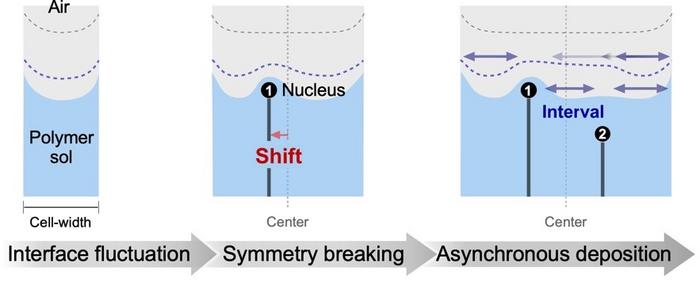In the intricate tapestry of nature, patterns abound—from the elegant spirals of blooming flowers to the distinctive stripes of a tiger’s coat, and even extending to the unique ridges of human fingerprints. These arrangements often tempt assumptions of perfect symmetry, yet intriguingly, many natural patterns reveal underlying asymmetries. This raises an enduring scientific puzzle: by what mechanisms do asymmetrical patterns spontaneously arise in natural systems? Addressing this question requires a rigorous exploration of the physical principles at play during pattern formation and symmetry breaking, especially under out-of-equilibrium conditions.
Groundbreaking research emerging from the Japan Advanced Institute of Science and Technology (JAIST) offers compelling insights into this phenomenon through the lens of meniscus splitting in evaporating polymer solutions. Led by Associate Professor Kosuke Okeyoshi and doctoral candidate Thi Kim Loc Nguyen, the study delves into the fundamental processes driving symmetry breaking within confined evaporating liquids, challenging previous theoretical abstractions that lacked empirical validation. Their findings, recently published in Advanced Science, enhance our understanding of asymmetrical pattern emergence by combining meticulous experiments with robust statistical analysis.
The core focus is on meniscus splitting—a phenomenon wherein a single evaporating liquid interface divides into multiple sections within a confined space. This effect is prominently exhibited when viscous polymer solutions evaporate in narrow gaps. The splitting does not occur evenly or symmetrically; instead, the meniscus segments form at irregular, unpredictable locations along the boundary. This asymmetric division effectively “breaks” the spatial symmetry of the system. Such behavior is characteristic of dissipative structures—self-organized and ordered states maintained far from thermodynamic equilibrium, analogous to patterns observed in biological tissues, precipitation phenomena, and atmospheric dynamics.
Prior investigations by Dr. Okeyoshi identified meniscus splitting in polymer dispersions as exemplifying dissipative structural behavior, but the precise factors dictating the symmetry and localization of these splits remained elusive. Through a series of controlled evaporation experiments coupled with probabilistic modeling, the JAIST team has now elucidated mechanisms governing this phenomenon, particularly highlighting the roles of boundary constraints and fluid material properties. Their approach prioritizes reproducing real-world physical behavior, moving beyond purely mathematical predictions.
In their experiments, chitosan—a polysaccharide known for its biocompatibility and viscous properties—served as the polymer solution. The liquid was confined within cells of varying width, and its evaporation dynamics were scrupulously monitored. Upon drying, the meniscus interface was observed to split predominantly into two or three distinct segments, yet the nucleation points initiating these splits consistently deviated from symmetric positions within the cell. This displacement of nucleation sites and its temporal progression was found to correlate strongly with the width of the evaporating cell and the rheological characteristics of the polymer solution.
The research unraveled critical details regarding the nature of nucleation in meniscus splitting. For binary splits—where the interface divides into two regions—nucleation points preferentially formed off-center, with this asymmetry amplifying as the confinement width increased. Ternary splits exhibited more complex behavior: asynchronous nucleation events influenced the spacing and timing of the segmentations, underscoring the interplay between spatial and temporal factors during symmetry breaking. This asynchronous formation is pivotal in understanding the evolution and stability of complex patterning in evaporating systems.
A noteworthy discovery concerns the spatial relationship between individual nuclei. The study found that the inter-nucleus spacing consistently exceeded twice the capillary length—a characteristic length scale determined by the balance of surface tension and gravitational forces at the liquid-air interface. For the chitosan solutions employed, this capillary length was approximately 5 millimeters, indicating that capillary effects substantially regulate the positional ordering of nucleation sites. Moreover, analogous behaviors were confirmed using other polysaccharide solutions, suggesting generalizability across soft polymeric materials.
The implications of these findings extend beyond pure scientific curiosity. Understanding the controlled manipulation of interface splitting and nucleation positioning could revolutionize polymer-based material design, influencing the fabrication of membranes, coatings, and films with finely tuned microstructures. Additionally, the study offers a bridge connecting theoretical pattern formation with tangible physical systems, fostering advances in materials science and engineering where non-equilibrium phenomena are exploited for functional purposes.
Dr. Okeyoshi emphasizes that their study "fills a crucial knowledge gap between abstract theoretical models and observable behaviors in natural systems," highlighting its interdisciplinary relevance. The uncovered principles may inform diverse fields, ranging from evolutionary ecology—where pattern formation influences organismal features—to meteorology, where dissipative structures are evident in cloud formation and atmospheric circulation patterns.
Further, this research underscores the profound interconnectedness of disciplines such as colloid and interface science, fluid dynamics, and polymer chemistry under the umbrella of nonequilibrium physics. Consideration of boundary conditions, material viscoelasticity, and capillary forces opens paths to designing artificial systems that mimic the adaptive complexity of natural phenomena.
By integrating experimental insights with statistical and probabilistic frameworks, the team presents a sophisticated model of symmetry breaking that captures the stochastic yet constrained nature of nucleation events in evaporating polymer interfaces. This approach accentuates how small variations in physical parameters ripple through system dynamics, culminating in macroscopic asymmetries.
Looking ahead, the confluence of these findings with advanced computational simulation, machine learning, and data science methodologies promises accelerated progress in unraveling emergent behaviors in soft matter and beyond. The ability to predict and harness asymmetric splitting processes could spur innovations in smart material synthesis, bio-inspired engineering, and dynamic system control.
In all, the JAIST study exemplifies how embracing complexity and exploring the nuances of interfacial phenomena and boundary effects illuminate the subtle dance of symmetry and asymmetry shaping much of the natural world around us. This research not only advances fundamental science but also paves a technological roadmap for exploiting the principles of meniscus splitting in future material innovations.
Subject of Research: Symmetry breaking mechanisms during meniscus splitting in evaporating polymer solutions
Article Title: Symmetry breaking in meniscus splitting: Effects of boundary conditions and polymeric membrane growth
News Publication Date: 3 June 2025
Web References:
https://doi.org/10.1002/advs.202503807
References:
Nguyen, T.K.L., Hatta, T., Ogura, K., Tonomura, Y., & Okeyoshi, K. (2025). Symmetry breaking in meniscus splitting: Effects of boundary conditions and polymeric membrane growth. Advanced Science. https://doi.org/10.1002/advs.202503807
Image Credits: Kosuke Okeyoshi from JAIST
Keywords: Materials science, Polymer chemistry, Statistics, Mathematics




